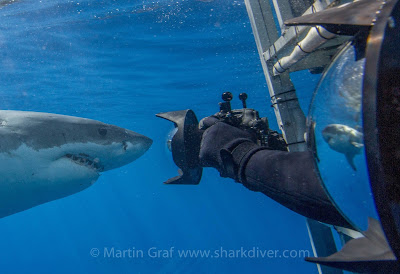Get to know “Screaming Mimi” Great White Shark at Guadalupe Island

We met “Screaming Mimi” a couple of years ago. When I first encountered her, I nicknamed her “Kinky”. She has a very distinct kink in her tail. I have no idea what caused that kink, since she doesn’t have any obvious scars or signs of injury. She was named “Screaming Mimi” by someone through the “Sponsor a shark” program of the Marine Conservation Science Institute. That sponsor program, is one of the ways they raise funds for the Photo ID database at Guadalupe Island.
Mimi is a very active and curious shark. When she encounters something new in the water, she exhibits a typical white shark trait. Unlike what most people think, white sharks don’t just attack when they encounter something they don’t know. They swim by close to check it out. It is actually quite funny some times. A couple of years ago, a beach towel blew overboard and started to drift down. 3 white sharks came by to investigate it. 2 of them jerked away and rapidly swam away, when the towel moved a little in the current. The 3rd. one kept swimming close to it, jerking away, and getting closer again. I don’t know if it eventually bit the towel or not, as I lost sight of both the shark and the towel in the distance.
Watch the video below of Mimi checking out my gopro camera that was attached to a long pole and handled from the boat.
You can see that they don’t just attack something they don’t know. The swim by and check things out first.
| Screaming Mimi ©Tim Peterson |
Mimi also likes to swim really close to the cages and makes eye contact with the divers.
Mimi is around 14′ long and not quite mature yet. It is amazing how big these sharks have to be, before they are mature and able to reproduce.
I hope we’ll see her again this year. She loves to swim around the cages, sometimes for hours. It never ceases to amaze me that we keep seeing the same individual sharks year after year. It’s not like they are resident sharks. The migrate thousands of miles each year, but come right back to the same spot at Guadalupe Island.
If you want to come face to face with a great white shark and would like to learn how to identify these sharks, join us on one of our “science” expeditions. We do have some spaces open and would love to introduce you to our sharks.
Call 619.887.4275, email crew@sharkdiver.com or visit www.sharkdiver.com for more information.
Let’s go shark diving!
Cheers,
Martin Graf
CEO Shark Diver
About Shark Diver. As a global leader in commercial shark diving and conservation initiatives Shark Diver has spent the past decade engaged for sharks around the world. Our blog highlights all aspects of both of these dynamic and shifting worlds. You can reach us directly at staff@sharkdiver.com.


